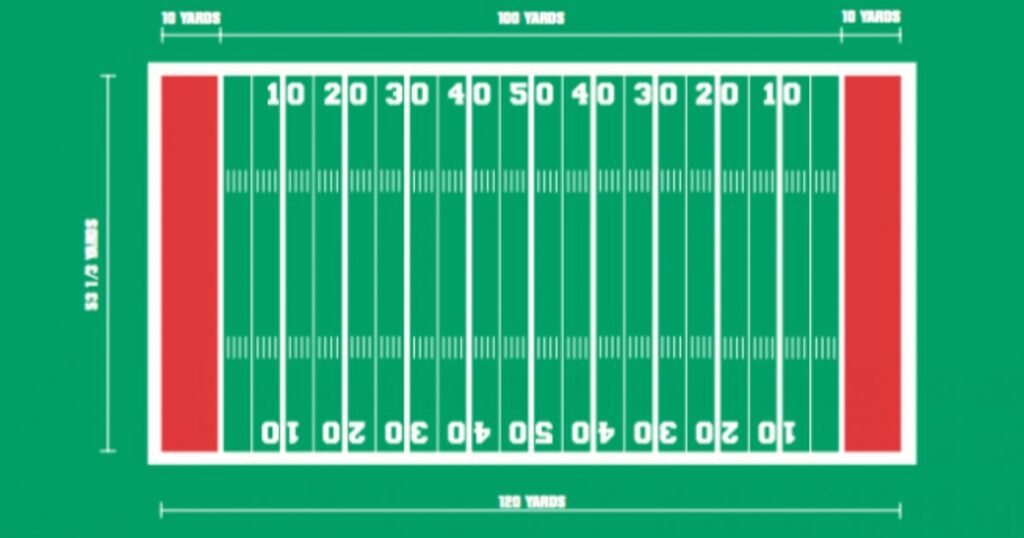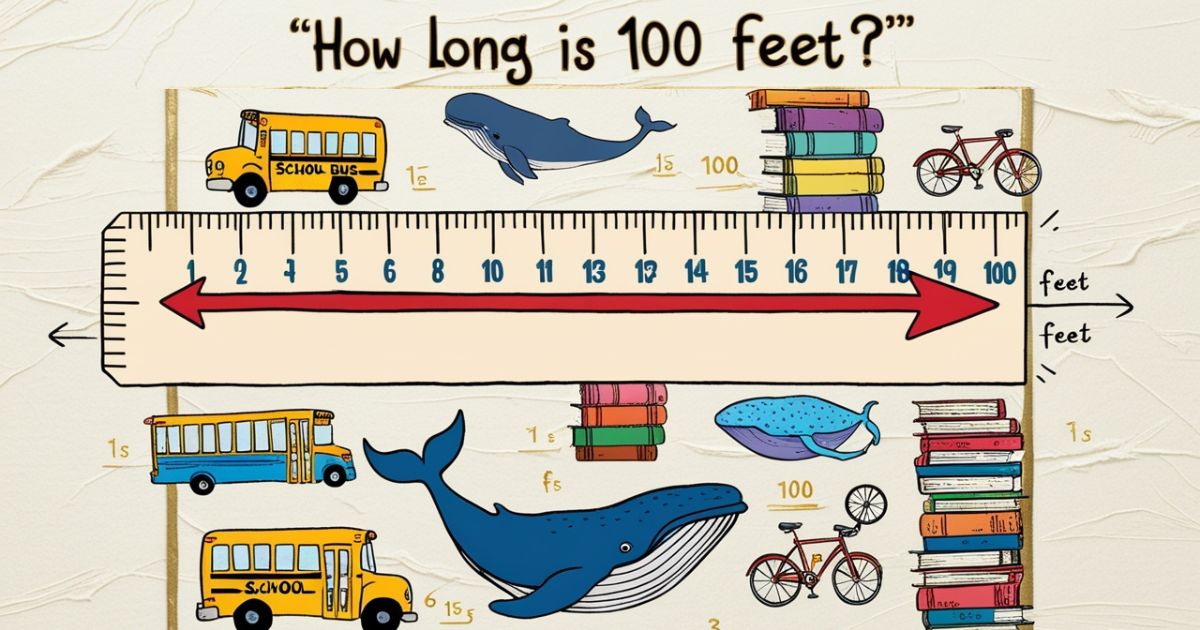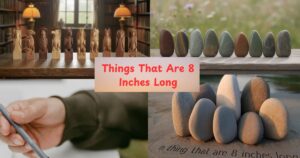Understanding how long is 100 feet matters more than you might think. This measurement shows up everywhere in daily life. You need it for home projects, school science work, and understanding sports fields.
When you drive, 100 feet is the safe following distance at highway speeds. In construction, knowing 100 feet distance examples helps with planning and safety rules.
The problem is that 100 feet is hard to picture in your mind. It’s too long to measure with a ruler but too short to drive. This guide will show you 12 amazing things that are 100 feet long or close to it. By the end, you’ll know exactly what 100 feet looks like in the real world.
Visualizing 100 Feet: Why It’s Hard to Picture
Most people struggle with visualizing 100 feet because our brains work better with smaller distances. We can easily picture 10 feet or even 20 feet. But 100 feet sits in an awkward middle ground. It’s longer than most rooms but shorter than city blocks.
This is where 100 feet visual comparison becomes useful. When you connect this measurement to familiar objects, your brain creates a mental picture. This skill helps in many areas of life. Contractors use it for estimating materials. Teachers use it for science lessons. Even drivers use it for safe following distances.
The key is finding the right reference points. Some objects are exactly 100 feet long. Others come close enough to give you a good sense of the distance. Let’s explore these real-world measurement comparisons that make 100 feet easy to understand.
Measurement Conversion Reference
Before diving into our examples, here’s a helpful conversion table for 100 feet in different units:
| Unit | Converts To | Formula | Example |
|---|---|---|---|
| 100 feet | 30.48 meters | Feet ÷ 3.281 | 100 ÷ 3.281 = 30.48m |
| 100 feet | 1,200 inches | Feet × 12 | 100 × 12 = 1,200 inches |
| 100 feet | 33.33 yards | Feet ÷ 3 | 100 ÷ 3 = 33.33 yards |
| 100 feet | 0.0189 miles | Feet ÷ 5,280 | 100 ÷ 5,280 = 0.0189 miles |
Understanding these conversions helps when you work with different measurement systems or need to explain distances to others.
1. Blue Whale: Nature’s 100-Foot Giant

The blue whale stands as nature’s perfect example of 100 feet. These magnificent creatures can reach lengths of 80 to 100 feet, with some specimens stretching even longer. Adult blue whales average around 90 feet, making them an excellent reference point for what is 100 feet long.
Blue whales represent the largest animals ever known to exist on Earth. Their massive size helps us understand just how significant 100 feet really is. When you picture a blue whale swimming through the ocean, you’re seeing roughly the same distance as 100 feet laid out in a straight line.
This comparison works well because blue whales are widely recognized and photographed. Most people have seen images or videos that show their incredible scale compared to boats or divers. The next time someone asks you how long is 100 feet, you can confidently say it’s about the length of a large blue whale.
2. Boeing 737 Wingspan: Around 100 Feet Wide
Commercial aviation gives us another excellent 100-foot scale reference. The Boeing 737 wingspan measures between 93 and 117 feet, depending on the specific model. The popular 737-800 has a wingspan of approximately 112 feet, while earlier models come closer to the 100-foot mark.
This aircraft comparison works particularly well because many people have flown on Boeing 737s or seen them at airports. The wingspan represents the distance from one wingtip to the other when viewed from above or below the aircraft.
Airport workers and pilots use these measurements daily for gate assignments and runway safety. The Boeing 737 size comparison helps travelers understand distance in a context they recognize. When you see a 737 at the gate, you’re looking at roughly 100 feet of aircraft width.
3. 10-Story Building: Nearly 100 Feet Tall

Building heights provide an excellent vertical reference for 100 feet examples. A typical 10-story building reaches approximately 100 to 120 feet in height. Each floor averages about 10 to 12 feet when you include ceiling space and structural elements.
This measurement applies to most residential apartment buildings and smaller office complexes. The exact height varies based on ceiling heights and architectural design, but 10 stories consistently puts you in the 100-foot range.
Urban planners and architects use these measurements for zoning laws and building codes. Many cities have height restrictions that reference these standard measurements. Understanding that 10 stories equals roughly 100 feet helps with architectural planning measurements and visualizing urban development projects.
4. Olympic Swimming Pool: Close to 100 Feet in Length
Sports facilities offer some of the most precise 100 feet distance examples. An Olympic swimming pool measures 50 meters in length, which converts to approximately 164 feet. However, many competition pools and training facilities use 25-meter pools, which measure about 82 feet long.
While not exactly 100 feet, swimming pools provide an excellent reference because they’re common and clearly marked. Most people have been to a pool and can visualize the length from one end to the other.
The pool comparison works especially well for understanding 100 feet in sports contexts. Competitive swimmers train by counting laps and distances, making pools a natural measurement reference for athletes and coaches.
5. Football Field Segment: From Goalpost to 100-Foot Mark

American football provides one of the most familiar 100-foot real life examples. A football field measures 120 yards (360 feet) from end zone to end zone. This means that 100 feet covers slightly more than one-quarter of the total field length.
More specifically, 100 feet equals about 33 yards on a football field. If you start at one goal line and walk toward the opposite end, you’ll cover 100 feet when you reach just past the 33-yard line.
Football stadiums are common reference points in American culture. Most people can visualize a football field and understand its proportions. This makes the football field segment an excellent tool for explaining 100 feet to students, construction workers, and anyone planning events or projects.
6. Giant Sequoia Tree Trunks: Reaching 100 Feet and Beyond
Nature provides impressive examples of things that are 100 feet long when we look at tree heights. Giant Sequoia trees commonly reach heights of 200 to 300 feet, but their first 100 feet of trunk represents a measurable section that people can visualize.
These ancient trees grow in California’s Sierra Nevada mountains. Their massive trunks create a striking vertical reference for 100 feet. When you stand at the base of a Giant Sequoia and look up, the first major branch section often sits at about 100 feet above ground.
Park rangers and forestry experts use these measurements for conservation planning and visitor education. The Giant Sequoia comparison helps people understand both the scale of these remarkable trees and the practical distance of 100 feet in a vertical context.
7. Mega Yachts: Luxury Boats Around 100 Feet Long

The boating world offers several examples of objects 100 feet in length. Mega yachts in the 100-foot category represent some of the most impressive private vessels on the water. These luxury boats typically range from 80 to 120 feet in overall length.
A 100-foot yacht provides serious ocean-going capability with multiple decks, guest cabins, and crew quarters. Marina operators use these measurements for slip assignments and harbor planning. The mega yacht size gives a clear picture of 100 feet as a horizontal distance on the water.
Yacht clubs and marine facilities regularly accommodate vessels in this size range. The comparison works well because many people have seen large yachts in harbors or on television, making it easy to visualize the scale.
8. Carnival Ride Arms: Stretching Up to 100 Feet
Amusement parks feature several rides with components that measure close to 100 feet in length. Carnival ride arms on attractions like Ferris wheels, swing rides, and spinning attractions often extend 50 to 100 feet from their central hub to the outer passenger areas.
Large Ferris wheels provide an excellent example. The spoke arms that connect the central hub to the passenger gondolas typically measure 80 to 120 feet, putting many in the 100-foot range. When the wheel turns, each arm sweeps through a circle with a 100-foot radius.
Ride engineers and safety inspectors work with these measurements daily. The carnival ride comparison helps explain 100 feet in a fun, memorable context that most people can relate to from visits to fairs and amusement parks.
9. City Block in Some Areas: Roughly 100 Feet Wide

Urban planning creates some interesting 100 feet in city design examples. Many city blocks measure approximately 100 feet in width, though this varies significantly by location and historical development patterns.
In cities like Portland, Oregon, and parts of Manhattan, blocks often measure close to 100 feet across. This measurement represents the distance from one side of the street to the other, including sidewalks and the roadway itself.
City planners use these measurements for traffic flow, emergency vehicle access, and pedestrian safety. Understanding that some city block widths equal about 100 feet helps with navigation and urban design discussions.
10. Suspension Bridge Segments: Spanning 100 Feet Gaps
Bridge engineering provides excellent examples of 100-foot spans in infrastructure projects. Many suspension bridge segments use 100-foot sections as standard building units. While major bridges span thousands of feet total, they’re often constructed in manageable 100-foot segments.
These segments represent the distance between major support cables or tower sections. Engineers design bridges by calculating how many 100-foot spans they need to cross a given distance. The suspension bridge comparison shows 100 feet as a practical building unit in large construction projects.
Bridge maintenance crews work with these measurements when planning repairs and inspections. The segmented approach makes it easier to manage and understand massive infrastructure projects.
11. Large Billboards: Up to 100 Feet Across
Outdoor advertising creates some impressive 100 feet examples in the form of large billboards. Major highway billboards and digital displays can measure 80 to 120 feet in width, with some reaching the full 100-foot mark.
These massive signs require special engineering and permits due to their size and wind resistance. Billboard companies use these measurements for pricing and installation planning. The large billboard size provides a horizontal reference that drivers see regularly on major highways.
Digital billboards in Times Square and other major cities often approach or exceed 100 feet in width. This creates a memorable visual reference that millions of people see annually.
12. Train Cars in Series: 100 Feet of Steel and Speed

Railroad transportation offers precise 100 feet distance examples through train car measurements. While individual freight cars typically measure 40 to 60 feet in length, a series of two to three cars often totals close to 100 feet.
Passenger train cars on Amtrak and commuter lines measure about 85 feet each, making them excellent single-unit references for understanding 100 feet. The train car length comparison works well because trains are common and their cars are clearly defined units.
Railroad engineers and conductors work with these measurements daily for coupling cars and planning train lengths. The railroad car comparison provides a moving reference that people can observe at crossings and stations.
How to Measure 100 Feet in Real Life (Practical Tips)
Understanding how to measure 100 feet practically helps in many situations. Here are several reliable methods for walking 100 feet and estimating this distance:
Step Counting Method:
The average adult takes about 120 to 140 steps to walk 100 feet. This assumes a normal walking pace with steps of approximately 2.5 feet each. Practice counting your steps over a known 100-foot distance to calibrate your personal measurement.
Car Length Method:
Most passenger cars measure 14 to 16 feet in length. This means about six to seven cars parked end-to-end equal roughly 100 feet. This method works well in parking lots and residential areas.
Telephone Pole Method:
Standard utility poles typically stand about 35 to 40 feet tall. If you imagine three telephone poles laid end-to-end horizontally, you get close to 100 feet.
Construction Methods:
Professional contractors often use measuring wheels or laser distance meters for precise 100-foot measurements. These tools provide accuracy needed for construction measurements and property surveys.
Why Understanding Length Visually Matters

Visual distance estimation skills prove valuable in numerous real-world situations. Emergency responders use these skills for scene safety and equipment placement. The recommended safe following distance while driving equals about 100 feet at highway speeds.
Engineering scale reference work requires accurate distance visualization. Architects and contractors must estimate distances quickly during site visits and planning meetings. Understanding 100 feet helps with zoning and setback rules that govern property development.
Event safety spacing often uses 100-foot measurements for crowd control and emergency access. Festival organizers and venue managers rely on these distance estimates for public safety planning.
Spatial relationships understanding improves with practice using consistent reference points. The more you connect 100 feet to familiar objects, the better your estimation skills become. This ability transfers to other distance measurements and improves overall spatial awareness.
Conversion Guide for Common Measurements
Here’s an expanded conversion reference for 100 feet in metric and other units:
Metric Conversions:
- 100 feet = 30.48 meters exactly
- 100 feet = 3,048 centimeters
- 100 feet = 0.03048 kilometers
Imperial System:
- 100 feet = 1,200 inches
- 100 feet = 33.33 yards (33 yards, 1 foot)
- 100 feet = 0.0189 miles
Time-Based References:
- Walking 100 feet takes about 1 to 1.5 minutes at normal pace
- Running 100 feet takes about 15 to 20 seconds for average adults
- 100 feet to walk represents roughly 120 to 140 steps
These conversions help when working with different measurement systems or explaining distances to people familiar with different units.
Practical Applications in Daily Life
Safe driving distance represents one of the most important uses of 100-foot understanding. Highway safety experts recommend maintaining at least 100 feet behind the vehicle ahead at speeds of 55 mph or higher. This distance provides adequate stopping time in emergency situations.
Emergency planning distance uses 100-foot measurements for evacuation routes and safety zones. Fire departments establish safety perimeters using these standard distances. Understanding 100 feet helps residents comply with emergency procedures.
Landscaping projects often involve 100-foot measurements for property lines, irrigation systems, and garden planning. Homeowners use these distances for fence installation and outdoor lighting placement.
Sports and recreation activities frequently reference 100-foot distances. Baseball fields use these measurements for foul territory and backstop distances. Soccer fields and other sports venues incorporate 100-foot measurements in their design standards.
Final Thoughts: Putting 100 Feet into Everyday Perspective
Understanding distance through visual references makes 100 feet a practical measurement tool rather than an abstract number. The 12 examples in this guide provide reliable reference points for various situations.
Whether you need to estimate safe driving distances, plan construction projects, or help students with science assignments, these comparisons make 100 feet easy to visualize.
The key to mastering accurate length estimation lies in regular practice with these reference objects. Start by identifying 100-foot distances in your daily environment.
Use the blue whale, Boeing 737, or 10-story building comparisons that work best for your situation. With practice, you’ll develop confident skills for estimating this important distance in any context.











